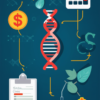
Cost Factors in Cord Blood Cell Separation
Factors Impacting the Cost of Cord Blood Cell Separation
The process of cord blood cell separation is a crucial step in the storage and preservation of valuable stem cells for potential future medical use. The cost of this procedure can vary significantly, depending on several key factors. Understanding these cost drivers is essential for individuals or families considering cord blood banking.
Cord Blood Collection and Processing Fees
One of the primary contributors to the overall cost of cord blood cell separation is the fee charged by the cord blood bank or collection facility. This fee typically covers the activities involved in the collection, transportation, and initial processing of the cord blood sample. The specific expenses may include the sterile collection kit, trained medical personnel to perform the collection, and the laboratory facilities required for the initial cell separation and cryopreservation.
Laboratory Equipment and Expertise
The equipment and expertise required to effectively separate the various cell types within the cord blood sample can also significantly impact the overall cost. Advanced technologies, such as flow cytometry or automated cell separation systems, may be employed to ensure a high-quality, viable sample. The maintenance and operation of this specialized equipment, along with the training and expertise of the laboratory staff, contribute to the overall cost of the cord blood cell separation process.
Storage and Cryopreservation Expenses
Once the cord blood cells have been separated, they must be carefully stored and cryopreserved to maintain their viability for potential future use. The cost of the cryogenic storage tanks, liquid nitrogen, and the ongoing monitoring and maintenance of the storage facility can add to the overall expense. Additionally, the length of time the sample is stored can affect the annual storage fees charged by the cord blood bank.
Regulatory Compliance and Quality Assurance
Cord blood banking is a highly regulated industry, and cord blood banks must adhere to strict quality standards and regulatory requirements. The costs associated with maintaining compliance, such as laboratory accreditations, quality control testing, and regulatory inspections, can be significant and contribute to the overall cost of the cord blood cell separation process.
Geographic Location and Market Factors
The geographic location of the cord blood bank and the local market dynamics can also influence the cost of cord blood cell separation. Factors such as the cost of living, labor rates, and the level of competition in the local market can all impact the pricing structure of the cord blood banking services.
By understanding these key cost factors, individuals and families can make informed decisions about the cost of cord blood cell separation and the overall investment in cord blood banking. Comparing pricing and service offerings from different cord blood banks can help ensure that the chosen provider offers the best value and meets the specific needs of the family.
Technological Advancements in Cell Separation Processes
The Evolving Landscape of Cell Separation Processes
In the ever-expanding realm of biotechnology, the field of cell separation has undergone a remarkable transformation, driven by the incessant pursuit of innovation and the need to optimize various research and medical applications. From pharmaceutical development to regenerative medicine, the ability to efficiently isolate and purify specific cell types has become a critical component in advancing scientific frontiers.
Centrifugation: The Foundational Approach
Centrifugation, a well-established technique, has long been the cornerstone of cell separation processes. By leveraging the differences in density and sedimentation rates, this method can effectively isolate various cell populations, including red blood cells, white blood cells, and platelets. However, as the demand for more precise and specialized separations has grown, researchers have sought to expand beyond the limitations of traditional centrifugation.
Magnetic-Activated Cell Sorting (MACS)
Magnetic-Activated Cell Sorting (MACS) has emerged as a powerful tool in the realm of cell separation. This technique utilizes superparamagnetic beads coated with antibodies that bind to specific cell surface markers, allowing for the targeted isolation of desired cell populations. The magnetic properties of the beads enable the separation of labeled cells from the rest of the sample, making MACS a highly selective and efficient method for cell purification.
Fluorescence-Activated Cell Sorting (FACS)
Fluorescence-Activated Cell Sorting (FACS) represents a transformative approach to cell separation. This technology combines the principles of flow cytometry with sophisticated cell sorting capabilities. By labeling cells with fluorescent dyes that bind to specific surface antigens or intracellular markers, FACS can precisely identify and isolate individual cell types with unparalleled accuracy. This method’s ability to sort cells at high speeds and with exceptional purity has made it indispensable in various research and clinical applications.
Microfluidic Cell Sorting
Microfluidic cell sorting has emerged as a cutting-edge innovation in the field of cell separation. By leveraging the unique properties of microscale fluid dynamics, this technology enables the manipulation and sorting of cells with remarkable precision. Microfluidic devices can be designed to exploit differences in cell size, deformability, or surface characteristics, allowing for the separation of specific cell populations with high efficiency and purity.
Affinity-Based Separation
Affinity-based separation techniques have revolutionized the way researchers approach cell isolation. These methods rely on the specific interactions between target cells and affinity ligands, such as antibodies or aptamers, which are immobilized on a solid support. As the sample flows through the affinity column or matrix, the target cells are selectively captured, enabling their separation from the rest of the cellular components.
Emerging Trends and Future Directions
The field of cell separation continues to evolve, with ongoing research and technological advancements driving the development of novel techniques. Emerging trends include the integration of microfluidics with affinity-based approaches, the use of label-free methods for cell identification, and the exploration of three-dimensional cell culture systems to better mimic the native cellular microenvironment.
As the demand for more sophisticated and efficient cell separation methods grows, researchers and developers are poised to push the boundaries of what is possible. By harnessing the power of these advanced technologies, scientists can unlock new frontiers in areas such as personalized medicine, tissue engineering, and the understanding of complex biological systems.
Regulatory Considerations for Cord Blood Cell Harvesting
Regulatory Oversight for Cord Blood Cell Harvesting
The process of harvesting and storing cord blood cells is subject to strict regulatory guidelines to ensure patient safety and product quality. Cord blood, which contains a rich source of hematopoietic stem cells, has become an increasingly valuable resource in the field of regenerative medicine. However, the collection, processing, and storage of cord blood must adhere to comprehensive regulatory frameworks to protect public health.
Compliance with Governmental Regulations
Cord blood collection and banking operations are regulated by various government agencies, both at the national and international levels. In the United States, the Food and Drug Administration (FDA) oversees the regulatory aspects of cord blood banking under the authority of the Public Health Service Act and the Federal Food, Drug, and Cosmetic Act. The FDA’s regulatory purview covers the manufacturing, labeling, and distribution of cord blood products, as well as the facilities and personnel involved in these processes.
Licensure and Accreditation Requirements
Cord blood banks must obtain the necessary licenses and accreditations to operate legally and to ensure compliance with industry standards. In the United States, cord blood banks must be registered with the FDA and must comply with the agency’s current Good Tissue Practice (cGTP) regulations. Additionally, many cord blood banks seek voluntary accreditation from organizations such as the AABB (formerly the American Association of Blood Banks) or the Foundation for the Accreditation of Cellular Therapy (FACT), which have established rigorous standards for cord blood banking practices.
Quality Assurance and Control Measures
Cord blood banking operations are subject to stringent quality assurance and control measures to maintain the integrity and safety of the collected samples. This includes the implementation of standard operating procedures (SOPs) for all aspects of the collection, processing, testing, and storage of cord blood units. Cord blood banks must also establish comprehensive quality management systems to monitor and document their compliance with regulatory requirements and industry best practices.
Donor Screening and Informed Consent
Proper donor screening and informed consent are critical components of the cord blood harvesting process. Potential donors must undergo a thorough medical history review and physical examination to assess their eligibility and to identify any potential contraindications or infectious disease risks. Additionally, donors must provide informed consent, which includes a clear understanding of the purpose, risks, and benefits of cord blood donation.
Traceability and Recordkeeping
Cord blood banks are required to maintain detailed records and documentation throughout the entire lifecycle of a cord blood unit, from collection to distribution or disposal. This traceability system enables the tracking of each unit’s origin, processing, and storage, which is essential for ensuring product quality, patient safety, and compliance with regulatory requirements.
Ongoing Monitoring and Reporting
Cord blood banks are subject to regular inspections and audits by regulatory authorities to verify their compliance with applicable laws and regulations. Additionally, cord blood banks must report any adverse events or product deviations to the appropriate regulatory agencies, such as the FDA, in a timely manner.
The regulatory framework governing cord blood cell harvesting is designed to protect public health, ensure product safety and quality, and foster innovation in the field of regenerative medicine. By adhering to these comprehensive regulations, cord blood banks can contribute to the advancement of this promising therapeutic modality while prioritizing the well-being of donors and recipients.
Optimizing Efficiency in Cord Blood Cell Extraction
Cord blood cell separation is a critical process in the field of regenerative medicine, as it enables the extraction and preservation of valuable stem cells from the umbilical cord blood. The cost factors involved in this process are essential considerations for both healthcare providers and patients. In this article, we will explore the key factors that contribute to the overall cost of cord blood cell separation and strategies to optimize efficiency.
Understanding the Cord Blood Cell Separation Process
The cord blood cell separation process involves the isolation of mononuclear cells, including stem cells, from the umbilical cord blood. This typically involves a series of steps, such as density gradient centrifugation, to separate the different cell populations. The efficiency of this process is crucial, as it directly impacts the yield and quality of the extracted stem cells.
Factors Influencing the Cost of Cord Blood Cell Separation
Equipment and Facility Costs: The specialized equipment required for cord blood cell separation, such as centrifuges, cell sorters, and clean rooms, can be a significant investment for healthcare providers. Maintaining and upgrading this equipment can also add to the overall operational costs.
Labor and Expertise: Cord blood cell separation requires skilled personnel, such as laboratory technicians and medical professionals, to perform the various steps involved. The cost of hiring and training these specialized personnel can be a considerable expense.
Reagents and Consumables: The separation process involves the use of various reagents, such as density gradient media, and single-use consumables, like collection bags and tubing. The ongoing cost of these supplies can add up quickly.
Quality Control and Regulatory Compliance: Ensuring the safety and efficacy of the extracted stem cells requires rigorous quality control measures and adherence to regulatory guidelines. This can involve additional testing, documentation, and compliance-related expenses.
Storage and Transportation: Cord blood units must be properly stored and transported to maintain the integrity of the cells. The costs associated with cryogenic storage, shipping, and logistics can be significant.
Strategies for Optimizing Efficiency in Cord Blood Cell Separation
Process Automation: Investing in automated cord blood cell separation systems can help streamline the workflow, reduce labor costs, and improve the consistency and reliability of the process.
Optimization of Reagent Usage: Careful optimization of reagent quantities and usage can help minimize waste and reduce the ongoing costs of consumables.
Streamlining Quality Control: Implementing efficient quality control protocols and leveraging technological advancements, such as real-time monitoring and data analysis, can help optimize the quality assurance process.
Collaborative Partnerships: Exploring collaborative partnerships with other healthcare providers, research institutions, or cord blood banks can help share the costs and resources associated with cord blood cell separation.
Continuous Process Improvement: Regularly reviewing and refining the cord blood cell separation process, incorporating feedback from stakeholders, and implementing best practices can contribute to ongoing cost optimization.
By addressing these cost factors and implementing strategies to optimize efficiency, healthcare providers can enhance the accessibility and affordability of cord blood cell separation, ultimately benefiting patients in need of regenerative therapies.
Economic Implications of Cord Blood Cell Separation
The Cost Factors in Cord Blood Cell Separation
The process of cord blood cell separation is a critical component in the field of regenerative medicine, with significant implications for both healthcare and the economy. This specialized technique involves the extraction and purification of stem cells from the umbilical cord blood, which can then be used for various medical treatments and therapies. Understanding the cost factors associated with this process is essential for healthcare providers, researchers, and policymakers to optimize resource allocation and ensure the accessibility of these crucial therapies.
Equipment and Instrumentation Costs
The separation of cord blood cells requires specialized equipment and instrumentation, including centrifuges, flow cytometers, and cell culture facilities. These specialized tools come with significant upfront costs, which can vary depending on the size and complexity of the operation. Larger facilities may require more advanced and expensive equipment, while smaller providers may opt for more affordable, yet less sophisticated, alternatives.
Labor and Operational Expenses
The cord blood cell separation process is labor-intensive, requiring highly skilled technicians and scientists to perform the necessary procedures. The cost of hiring and training this specialized workforce can be a significant contributor to the overall expenses associated with this service. Additionally, ongoing operational costs, such as maintenance, utilities, and compliance with regulatory standards, can further add to the financial burden.
Regulatory Compliance and Licensing
The cord blood cell separation industry is subject to strict regulatory oversight, with various guidelines and standards that must be met to ensure the safety and efficacy of the final product. Obtaining the necessary licenses and certifications, as well as adhering to ongoing compliance requirements, can incur substantial costs for healthcare providers and research facilities.
Reagents and Consumables
The cord blood cell separation process requires a range of specialized reagents and consumables, such as cell culture media, separation columns, and cryogenic storage containers. The costs of these materials can vary depending on the scale of the operation, the specific techniques employed, and the quality of the products used.
Facility and Infrastructure Costs
Dedicated facilities for cord blood cell separation, including specialized laboratories and storage spaces, come with significant real estate, construction, and maintenance costs. Providers must carefully consider the optimal size and configuration of their infrastructure to balance efficiency, capacity, and cost-effectiveness.
Transportation and Logistics
Cord blood samples often need to be transported from the point of collection to the separation facility, which can incur additional costs for shipping, handling, and temperature-controlled storage. Efficient logistics and supply chain management are crucial to minimizing these expenses.
Research and Development
Ongoing investments in research and development are essential for advancing the field of cord blood cell separation, leading to improved techniques, increased efficiency, and the development of new therapeutic applications. These R&D costs can be a significant factor in the overall expenses associated with this industry.
By understanding these various cost factors, healthcare providers, researchers, and policymakers can make informed decisions about the allocation of resources, the pricing of cord blood cell separation services, and the development of strategies to improve the accessibility and affordability of these vital therapies.
Conclusion
Cord blood cell separation is a critical process that plays a pivotal role in the field of regenerative medicine and cellular therapies. The cost factors associated with this procedure are complex, involving a range of technological, regulatory, and economic considerations.
Technological advancements have been a driving force in enhancing the efficiency and cost-effectiveness of cord blood cell separation. Innovative separation methods, such as density gradient centrifugation and magnetic-activated cell sorting, have improved the yield and purity of the extracted cells, reducing the overall costs associated with the process. Additionally, the development of automated systems has streamlined the cell separation workflow, minimizing the need for manual labor and ensuring consistent outcomes.
Regulatory considerations are another crucial aspect in determining the cost factors of cord blood cell separation. Stringent guidelines and standards set by governing bodies, such as the FDA and European Medicines Agency, ensure the safety and quality of the extracted cells. Compliance with these regulations, which may involve extensive testing, documentation, and facility requirements, can significantly impact the overall cost of the procedure.
Optimizing the efficiency of cord blood cell extraction is another key factor in managing costs. Strategies such as improving collection techniques, optimizing cryopreservation methods, and enhancing cell recovery rates can all contribute to reducing the per-unit cost of the final product. Additionally, leveraging economies of scale through increased cord blood banking and centralized processing facilities can help spread the fixed costs across a larger volume of operations.
The economic implications of cord blood cell separation extend beyond the direct costs of the procedure itself. The potential therapeutic applications of these cells, such as in the treatment of hematological disorders, immune system disorders, and regenerative therapies, present significant market opportunities. As the demand for cord blood-derived cellular therapies grows, the cost-benefit analysis of cord blood cell separation becomes increasingly important, particularly in ensuring the accessibility and affordability of these treatments for patients.
The cost factors associated with cord blood cell separation are multifaceted, involving a complex interplay of technological, regulatory, and economic considerations. Continuous advancements in separation techniques, optimization of extraction processes, and strategic considerations of the broader economic landscape will be crucial in driving down the costs and making cord blood-derived cellular therapies more accessible to patients in need. As the field of regenerative medicine continues to evolve, the importance of cost-effective and efficient cord blood cell separation will only continue to grow, underscoring the need for ongoing research and innovation in this critical area.











